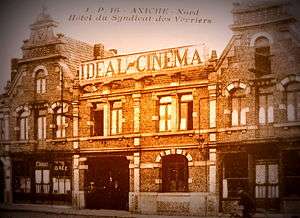L'Idéal Cinéma Jacques Tati
| L'Idéal Cinéma | |
| Former names | La Salle de L’Hôtel du Syndicat CGT, Splendid Cinéma à L'Hôtel du syndicat, L'Idéal Cinéma |
|---|---|
| Address | 10 Rue Wambrouck |
| Location | Aniche, France |
| Coordinates | 50°19′50″N 3°15′07″E / 50.33056°N 3.25194°ECoordinates: 50°19′50″N 3°15′07″E / 50.33056°N 3.25194°E |
| Owner | City of Aniche |
| Type | Indoor theatre |
| Capacity | 187 |
| Construction | |
| Built | 1900-1901 |
| Opened |
26 January 1902 23 November 1905 (films) 3 June 1995 (re-open) |
| Renovated | 1995, 2012 |
| Closed | 4 February 1977(first run) |
| Demolished | ?? |

L'Idéal Cinéma Jacques Tati is a movie theater in Aniche, France, and is claimed to be the oldest active public movie theater in the world.[1] The building was originally constructed for La Chambre Syndicale des Verriers (Glass Workers Union), and inaugurated as the local headquarters of the General Confederation of Labour (CGT) on 26 January 1902.[2] The theater's first public film performance took place on 23 November 1905.[3] Since then, the building has been renovated several times.
History
At the turn of the 20th century, Aniche was a town with a population of about 8000 that was centered around the coal and glass industry. La Chambre Syndicale des Verriers (Glass Workers Union),[2] which had at its peak about 1800 members, was part of the General Confederation of Labour (CGT). In 1900, under the chairmanship of Albert and Paul Gallet Quévy, the union purchased land on Rue de la Pyramide (later named Rue Wambrouck) for sixteen thousand francs,[2] for the purpose of constructing a new headquarters and to have a large multi-purpose hall for meetings and events. Construction took place from 1900-01 for L’Hôtel du Syndicat CGT.[2] On 26 January 1902, the building was inaugurated[2] with Charles Adolphe Scelles as mayor. Besides meetings, the hall had its first theater performance on 18 January 1903.[2]
On 23 November 1905, the meeting hall had its first film viewing.[2] The film showcased was the 1902 French silent film A Trip to the Moon by Georges Méliès and the seat capacity at the time was 600. The management frequently welcomed Pathé and the Gaumont Film Company, but signed with the Splendid Cinéma company.[3] It would showcase performances in three parts; each part would contain three different films. The theater's manager was Eloi Joseph Lanoy, who became mayor of Aniche in 1910. When Splendid Cinéma withdrew in 1911, the management worked with Excelsior-Rehauss and Rex Cinema to continue showing films.[3] During World War I, the theater was used by the Hispano-American Committee, under the auspices of the Red Cross, to deliver food supplies to the region until 31 March 1919.
On 21 December 1912, the management responded to a decree to separate the projection room from the seating, and to attach the seats to the floor. Louis Pol took over as a manager. The theater was renamed to L'Idéal Cinéma.[3] In 1922, the management purchased a projector for 22,915 francs.[2] In the mid-1920s, the union's numbers dropped to about 400 members in 1925, and had to deal with a crisis in the glass industry in 1927. The union eventually recovered, and in 1936, the cinema seating grew to 850. The theater also faced competition from Royal Cinéma. In May 1940, when the Germans occupied Aniche, the building's ownership was transferred to the town.[2] During World War II, the management was required to keep the lights on during the projection of propaganda newsreels produced by Die Deutsche Wochenschau, in order to identify disruptors and demonstrators.[3]
After World War II, the theater enjoyed increased activity with the influx of American films that had been banned during the occupation,[3] but had a decline in the 1950s as moviegoers began watching television. In 1955, Pol retired, and the theater hired Charles Moreau, who planned a renovation of the lower facade of the building in 1960. On 30 June 1967, the Royal Cinéma closed its doors, making L'Idéal Cinéma the sole movie theater in town.[3] In 1976, Alain Moret succeeded Moreau as manager of the theater.[3] On 4 February 1977, the theater was forced to close for not complying with municipal security regulations.[4][2] In 1981, there were brief negotiations to reopen the building.[2]
On 28 January 1991, Mayor Michel Meurdesoif and Rene Gumez, the secretary general of the Union des Syndicats CGT des Verriers d'Aniche, signed a lease agreement to rebuild the theater.[2] With manager Alain Moret, they commissioned artist and sculptor Georges Hugot. The resulting theater hall was half the size of the original, and was named after French filmmaker Jacques Tati. On 3 June 1995, the city held an inaugural ceremony for the Culturel et Communal Claude-Berri building complex, which was named after French actor/filmmaker Claude Berri.[2][3] The complex contains L'Idéal Cinéma Jacques Tati as well as a cultural hall for Pol.[4]
On 31 December 2012, the theater celebrated the arrival of a 3D digital system, as well as new seats and decor. It accommodates 187 seats and provides access for those with reduced mobility.[4][5]
References
- ↑ Carder, Doug (2013-09-28). "'Cinemagic' find". The Ottawa Herald. Retrieved 2014-01-24.
- 1 2 3 4 5 6 7 8 9 10 11 12 13 "Aniche – le Jacques Tati" (in French). De la suite dans les images. Retrieved 2014-01-24.
- 1 2 3 4 5 6 7 8 9 "LA FOLLE HISTOIRE DU CINEMATOGRAPHE CONTEE PAR ROGER CONSIL" [The crazy history of cinematography storytelling by Roger Consil] (in French). Mairie d'Aniche – site officiel (Mayor of Aniche official site). Retrieved 2014-01-24.
- 1 2 3 "L'Idéal Cinéma Jacques-Tati rouvre ses portes, la séance peut commencer…..". Mairie d'Aniche - site officiel (Mayor of Aniche official site) (in French). 2012. Retrieved 2014-01-24.
- ↑ "L'Idéal cinéma Jacques-Tati s'est fait une beauté et rouvre aujourd'hui - Articles locaux" (in French). lavoixdunord.fr. Retrieved 2014-01-24.